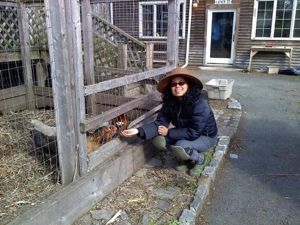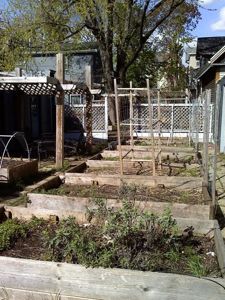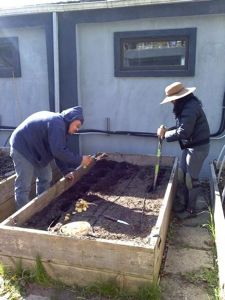Sustainable City Gardening
Air Date: Week of May 21, 2010

Patti Moreno feeds her chickens scraps from the gardens. (Photo: Bobby Bascomb)
Gardening season is here again but the urban gardener doesn't need to be confined to growing plants in containers. In Boston, Patti Moreno, the self-proclaimed Garden Girl, grows so much food in her backyard that she opens up a small farmer's market each summer. Living on Earth's Bobby Bascomb went to check out a garden that is anything but garden variety.
Transcript
CURWOOD: Michele Obama does it. Thousands of New Yorkers do it. And you too can grow a garden – even if you live in the inner city. That’s the message Pati Moreno is pushing. She’s a native New Yorker, but admits her first horticultural attempts were dismal.
MORENO: Starting out I was horrible. I killed everything I ever planted, but my first success was with some fruit trees. I actually grew apples! They were the most delicious thing ever! So, I was like oh my gosh I can actually plant a plant and eat from it too and I just started branching out from there.
CURWOOD: Today Pati Moreno cultivates 30 raised beds in Boston. She produces so many zucchini and tomatoes and greens each summer she opens up a farm stand in front of her home. Living on Earth’s Bobby Bascomb headed to Boston’s Roxbury neighborhood to check out Pati's brand of urban sustainable living.
[CHICKENS]
MORENO: I just want to see if there are any eggs under these ladies over here. No! No eggs, bummer.
[SOUNDS OF CHICKEN COOP]

An 8 by 6 foot greenhouse was converted into a chicken coop. Patti sells extra eggs to her neighbors in her summer farmer’s market. (Photo: Bobby Bascomb)
MORENO: They start producing eggs actually at 20 weeks, that’s like a few a week. And as they mature- one day.
BASCOMB: For the average person that whatever to have backyard chickens, how feasible is it?
MORENO: It’s so easy. It’s much easier than a dog. You never have to walk them, unless you want to! They are my garden helpers. They scratch and till the soil for me, they eat all the bugs, and then, they fertilize it.
[SOUNDS OF MOVING THROUGH GATE]
MORENO: Let’s go over to my smaller garden. We’re going go get to work a little bit over here.
BASCOMB: Oh, you’re going to put me to work?
MORENO: And we’re going to put you to work.
[SOUNDS OF SHOVEL]

Patti has 30 raised bed gardens for growing a wide variety of vegetables and cuisine types. (Photo: Bobby Bascomb)
MORENO: This is basically a demonstration garden that I wanted to put together to show what you could do on like an average size backyard. Being Puerto Rican one of the raised beds I plant every year is a Latin Caribbean mixture of beans and peppers and cilantro—all of the things that you would need to make this thing call sufrito, which is like a base flavor for a lot of the food that you would eat in Latin Caribbean culture.
[Johnny Pacheco “Azucar Mami” from Viva Salsa (Charly Records 1991)]
MORENO: I have a four-by-four raised bed that’s two tiers high, and then I have a square-foot grid that I made that fits right into the raised bed and that’s basically going to be our guide as to where we’re planting everything.
[“Mayor G from El Espiritu Jibaro (Sunnyside Records 2007)]
MORENO: We’re going to companion plant. In this whole bed we’re going to be able to make an amazing stir-fry, so we’re going to have to eggplant, a Siamese dragon stir-fry mix, which has tons of different Asian greens in them.
[SOUNDS OF BAGS OF DIRT MOVING]

Patti holds seeds for an Asian stir fry mix. (Photo: Bobby Bascomb)
MORENO: Arranging different configurations of raised beds is like my hobby. That’s just fun for me, that’s Saturday night—planning raised beds! It’s a party!
[Johnny Pacheco “Azucar Mami” from Viva Salsa (Charly Records 1991)]
ROBERT: Look, Asian greens are nice. It’s nice, it’s spicy, it’s a different taste, but how about some potatoes and some corn and some lettuce?
[Johnny Pacheco “Azucar Mami” from Viva Salsa (Charly Records 1991)]
ROBERT: My name is Robert Patton-Spurill and I’m Patricia’s husband. I want a record of potato. I want to do 800 pounds of potato and I’m trying to do 200 pounds of corn.
BASCOMB: Wait a second, how big is this garden that you’re growing all of this in?

Patti placed an old skylight over a garden bed to create a mini greenhouse. Inside it is the square foot grid she uses to demarcate where to plant her seeds. (Photo: Bobby Bascomb)
ROBERT: Very small, it’s not big. It’s only four by eight.
MORENO: This part is for his man garden this year.
ROBERT: You know a lot of people grow potatoes in trash barrels, and that’s the coolest thing ever because basically they put the potatoes at the very bottom in like 6 inches of soil, and as it grows up they keep filling in soil around it, and then at the end of the year they dump it out on a tarp, pull all the potatoes out, and they start over again.

Patti and her husband Rob plant potatoes in his “man garden.” (Photo: Bobby Bascomb)
And then that one trash can version people have done really gigantic amounts of potato in it.
MORENO: We every year manage to eat so many meals from the garden. You know the supermarket people do not know me.
[“Mayor G from El Espiritu Jibaro (Sunnyside Records 2007)]
MORENO: Urbanites—it’s our responsibility to start being as sustainable as we possibly can because in the very near future, there’s going to be 70 percent of the world’s population that’s going to live in cities.
[“Mayor G from El Espiritu Jibaro (Sunnyside Records 2007)]
MORENO: Anything you grow and then eat is going to be the tastiest thing you’ve ever had, as long as you don’t burn it you’re fine, and it’s a lot of fun.

Patti Moreno feeds her chickens scraps from the gardens. (Photo: Bobby Bascomb)
[“Mayor G from El Espiritu Jibaro (Sunnyside Records 2007)]
CURWOOD: Living on Earth’s Bobby Bascomb prepared that audio portrait of Pati Moreno, and her inspiring garden, and there’s more at our website, l-o-e dot org.
[“Mayor G from El Espiritu Jibaro (Sunnyside Records 2007)]
CURWOOD: Coming up: the heady scent of hidden chemicals in your perfume—that’s just ahead on Living on Earth.
ANNOUNCER: Support for the environmental health desk comes from the Cedar Tree Foundation. Support also comes from the Richard and Rhoda Goldman Fund for coverage of population and the environment. And from Gilman Ordway for coverage of conservation and environmental change. This is Living On Earth on PRI, Public Radio International.
Links
Patti Moreno’s Website: Garden Girl TV has dozens of how-to videos
The Square Foot Gardening Foundation
"> Click here for a Garden Girl video on building a raised bed for urban gardening.
Living on Earth wants to hear from you!
Living on Earth
62 Calef Highway, Suite 212
Lee, NH 03861
Telephone: 617-287-4121
E-mail: comments@loe.org
Newsletter [Click here]
Donate to Living on Earth!
Living on Earth is an independent media program and relies entirely on contributions from listeners and institutions supporting public service. Please donate now to preserve an independent environmental voice.
NewsletterLiving on Earth offers a weekly delivery of the show's rundown to your mailbox. Sign up for our newsletter today!
 Sailors For The Sea: Be the change you want to sea.
Sailors For The Sea: Be the change you want to sea.
 The Grantham Foundation for the Protection of the Environment: Committed to protecting and improving the health of the global environment.
The Grantham Foundation for the Protection of the Environment: Committed to protecting and improving the health of the global environment.
 Contribute to Living on Earth and receive, as our gift to you, an archival print of one of Mark Seth Lender's extraordinary wildlife photographs. Follow the link to see Mark's current collection of photographs.
Contribute to Living on Earth and receive, as our gift to you, an archival print of one of Mark Seth Lender's extraordinary wildlife photographs. Follow the link to see Mark's current collection of photographs.
 Buy a signed copy of Mark Seth Lender's book Smeagull the Seagull & support Living on Earth
Buy a signed copy of Mark Seth Lender's book Smeagull the Seagull & support Living on Earth

